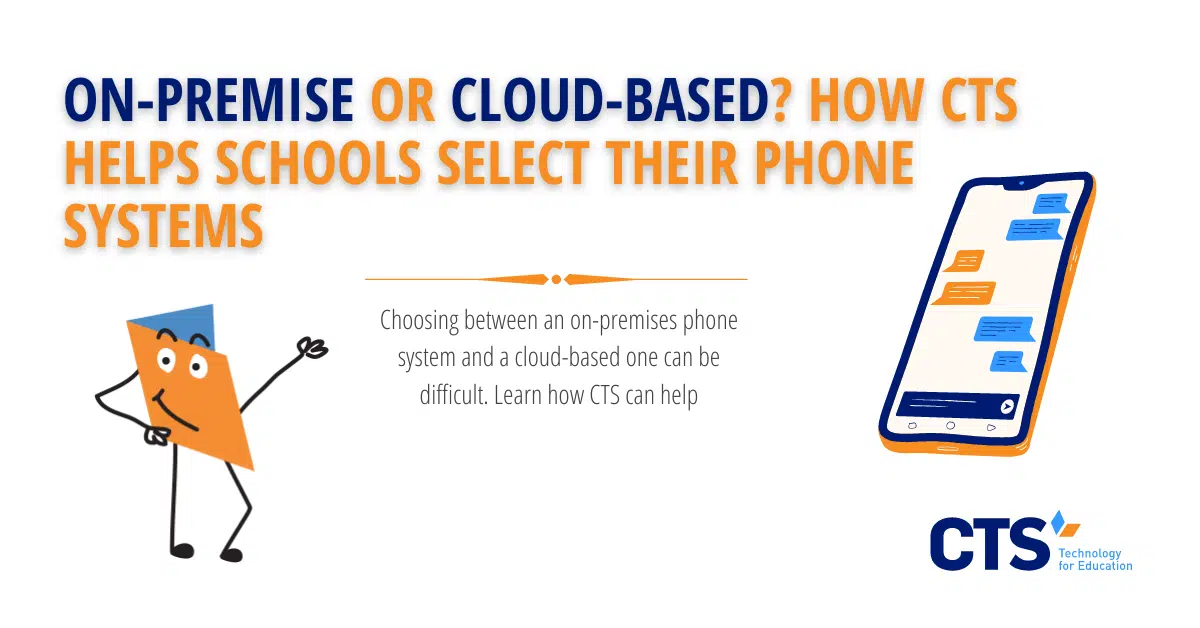Phone systems play an essential role in daily school life.
Phone systems keep the lines of communication between schools and the outside world open. Especially, when it comes to communicating with parents and families. Calls from the school nurse to let a parent know that their child is sick or calls from a parent asking that their child not take the bus that day are frequent occurrences.
Today’s phone systems are relied upon for so much more than just making phone calls. Beyond communication, phone systems are also used as PA systems for schoolwide announcements or intercoms for direct communication between an individual classroom and the main office. They can also serve as the school’s bell system; the chimes announcing the beginning and end of each period can be programmed to ring through a school’s phone system. Because of this, when phones aren’t working, it can cause more than just communication challenges. It can cause operational ones as well.
Given the significance of these systems, school leaders are asking themselves ‘which is the best phone system for my school?’
Schools can choose between an on-premises phone system and a cloud-based one. There isn’t one clear answer about which system a school should select. Each approach has its advantages, so it really depends on a school’s needs and budget.
With on-premises systems, a school typically purchases all of the equipment upfront, including the server, and it’s all stored on the school’s premises. With this option, the school’s IT staff has control of the system and is responsible for performing any changes, making any updates, and conducting ongoing maintenance.
With the cloud-based option, the only equipment that a school would typically purchase upfront would be the phones themselves. The server, and other related equipment, would be hosted off-site by a third-party provider. With this setup, schools would have some control over moves or changes, but the provider would be responsible for all updates and maintenance.
If a school prefers to have full control of its system, then the on-premises option might be a good fit. Conversely, if a school’s preference is for an external party to manage the system and its maintenance, the cloud-based option might be best.
With an on-premises system, schools have a higher upfront cost but they own their equipment.
In this process, like in others, budget is an important factor in the decision-making. For both options, schools will pay some sort of upfront costs and a monthly fee. With the on-premises option, schools will have a higher upfront cost because the necessary physical equipment requires a significant capital investment. There will also be costs for maintenance and upgrades over time.
With a cloud-based option, schools will have some initial upfront costs, but they are able to skip the large equipment-related ones. The third-party provider is responsible for maintaining the system so will handle maintenance and upgrades internally and those are factored into the monthly fee.
Scaling up is easier with cloud-based systems.
When selecting a phone system, another consideration for schools is their long-term footprint. Is the school currently at scale? Or will grades, classrooms, teacher workrooms, or additional offices be added in the future? Adding additional lines and scaling up is possible with both on-premise and cloud-based options, but it is easier with cloud-based.
With an older on-premises system, to add a desk phone you’ll need to adjust the wiring in the server closet and add a line card. With a cloud-based system, adding an additional line can be as simple as the click of a button in an admin portal.
Does your school need to provide flexibility for remote staff?
Schools’ current need for remote access isn’t as high as it was during the height of the COVID-19 pandemic when virtual instruction was the primary means of teaching. However, schools may still have some staff working remotely or may have a need for remote access to phones from time to time, like during snow days or other school closures. On-premises phone systems can handle remote users but the process can be complex or expensive and oftentimes needs additional equipment. Cloud-based phone systems come with this capability in a user-friendly way so that staff can make and receive phone calls, using a school number, without being on campus.
At CTS, we help schools accomplish their unique missions.
After reading through the similarities, differences, and pros and cons of on-premise and cloud-based phone systems, you may still have questions about which approach is best for your school. Reach out to us at CTS, we can help you make that decision. Our team is comprised of former teachers and school operations professionals who understand the unique needs and challenges of the school environment. We’ve worked with more than 60 schools across the United States to improve the quality of their technology programming. Contact us today to learn more about our services and how CTS can help ensure that your technology programming effectively serves teachers and students and is aligned with your school’s specific instructional needs.




